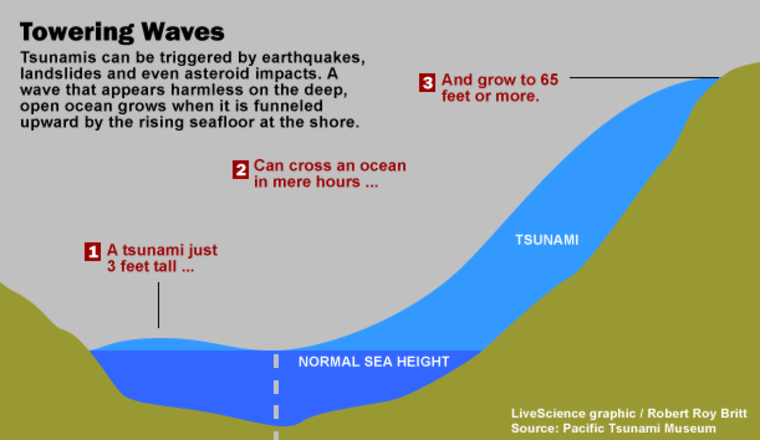A major earthquake that struck Chile overnight has sent a tsunami out into the Pacific Ocean, prompting a tsunami watch along the coasts of California and parts of Alaska and a tsunami warning for Hawaii.
A watch is a cautionary statement that does not mean waves are imminent. Officials are not sure what nations could be affected by tsunami, but they caution that the entire Pacific Basin is at risk.
A warning, as issued for Hawaii, means waves are imminent and residents should seek high ground. Early reports of waves exceeding 7 feet have been reported near the epicenter of the earthquake. The 8.8-magnitude temblor was centered offshore, 200 miles (325 km) southwest of Santiago, Chile.
"A tsunami has been generated that could cause damage along coastlines of all islands in the state of Hawaii," according to a bulletin from NOAA, the parent organization of the National Weather Service. The waves would be expected to reach Hawaii starting at 11:19 a.m. local time.
Other than timing, however, tsunamis are highly unpredictable.
How tsunamis work
A tsunami is not a single wave, but a series that behave much like the waves rippling out from a stone dropped in a pond. Each wave can last five to 15 minutes, and the danger can last for hours after the initial wave arrives.
"Tsunami waves heights cannot be predicted and the first wave may not be the largest," according to today's NOAA statement.
Tsunamis, which can travel over the ocean surface from many hundreds of miles, can be generated when chunks of the planet's crust separate under the seafloor, causing an earthquake. Here's what happens: One slab of lifting crust essentially rapidly acts as a giant paddle, transferring its energy to the water.
Tsunamis can also be caused by volcanic eruptions, underwater detonations and even landslides.
The resulting waves are hard to predict for several reasons. Nobody knows how a quake has affected the seafloor until hours, days or even months after the event. And a tsunami is almost imperceptible on the open ocean, rising to full ferocity only as it nears the shore.
While more tsunami-sensing buoys cover the ocean than before the devastating 2004 Indian Ocean tsunami, these waves can still be missed.
Not all seafloor earthquakes will generate a tsunami — if the friction between the crustal plates occurs very deep below the ocean floor or move in a way that causes a minimal paddle effect, a tsunami isn't as likely to form.
Major tsunamis in history
The 2004 quake just off the coast of Sumatra, Indonesia, was colossal, eventually put at magnitude 9.3. But an 8.7-magnitude earthquake in 2005 that originated at the same location, while large enough to generate a devastating tsunami, scientists say, did not do so. The exact reasons remain mysterious.
The 2004 tsunami, and those spurred by the 9.2-magnitude Great Alaska Earthquake in 1964, were examples of teletsunamis, which can cross entire oceans.
Several devastating tsunamis have occurred throughout recorded history, including one that leveled Lisbon, Portugal in 1755 and one generated by the explosion of Krakatoa in Indonesia that drowned an estimated 36,000 people.
Except for the largest tsunamis, such as the 2004 Indian Ocean event, most tsunamis do not result in giant breaking waves; instead they come in much like very strong and fast-moving tides, according to the U.S. Geological Survey. As a tsunami nears the shoreline, the rising seafloor forces a wave that might have been just inches tall into a monster that can be several feet high.
The Pacific Ocean basin is particularly prone to tsunamis. Last year, a study of earthquake faults off the coast of Alaska predicted that the risk of tsunamis for the U.S. West Coast is higher than had been thought. Previous research found that a major tsunami hitting Southern California could cause $42 billion in damage.
